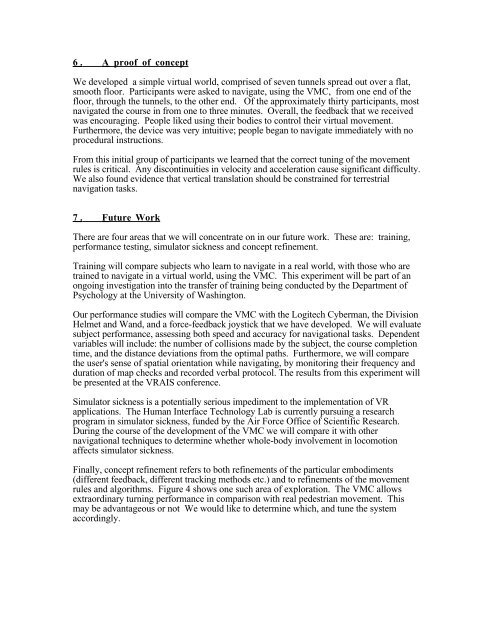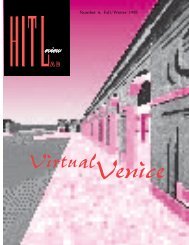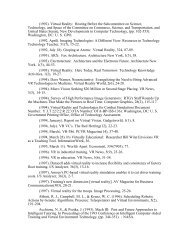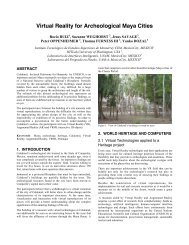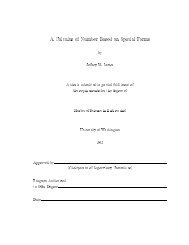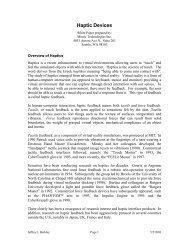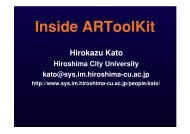The Virtual Motion Controller - Human Interface Technology ...
The Virtual Motion Controller - Human Interface Technology ...
The Virtual Motion Controller - Human Interface Technology ...
Create successful ePaper yourself
Turn your PDF publications into a flip-book with our unique Google optimized e-Paper software.
6 .<br />
A proof of concept<br />
We developed a simple virtual world, comprised of seven tunnels spread out over a flat,<br />
smooth floor. Participants were asked to navigate, using the VMC, from one end of the<br />
floor, through the tunnels, to the other end. Of the approximately thirty participants, most<br />
navigated the course in from one to three minutes. Overall, the feedback that we received<br />
was encouraging. People liked using their bodies to control their virtual movement.<br />
Furthermore, the device was very intuitive; people began to navigate immediately with no<br />
procedural instructions.<br />
From this initial group of participants we learned that the correct tuning of the movement<br />
rules is critical. Any discontinuities in velocity and acceleration cause significant difficulty.<br />
We also found evidence that vertical translation should be constrained for terrestrial<br />
navigation tasks.<br />
7. Future Work<br />
<strong>The</strong>re are four areas that we will concentrate on in our future work. <strong>The</strong>se are: training,<br />
performance testing, simulator sickness and concept refinement.<br />
Training will compare subjects who learn to navigate in a real world, with those who are<br />
trained to navigate in a virtual world, using the VMC. This experiment will be part of an<br />
ongoing investigation into the transfer of training being conducted by the Department of<br />
Psychology at the University of Washington.<br />
Our performance studies will compare the VMC with the Logitech Cyberman, the Division<br />
Helmet and Wand, and a force-feedback joystick that we have developed. We will evaluate<br />
subject performance, assessing both speed and accuracy for navigational tasks. Dependent<br />
variables will include: the number of collisions made by the subject, the course completion<br />
time, and the distance deviations from the optimal paths. Furthermore, we will compare<br />
the user's sense of spatial orientation while navigating, by monitoring their frequency and<br />
duration of map checks and recorded verbal protocol. <strong>The</strong> results from this experiment will<br />
be presented at the VRAIS conference.<br />
Simulator sickness is a potentially serious impediment to the implementation of VR<br />
applications. <strong>The</strong> <strong>Human</strong> <strong>Interface</strong> <strong>Technology</strong> Lab is currently pursuing a research<br />
program in simulator sickness, funded by the Air Force Office of Scientific Research.<br />
During the course of the development of the VMC we will compare it with other<br />
navigational techniques to determine whether whole-body involvement in locomotion<br />
affects simulator sickness.<br />
Finally, concept refinement refers to both refinements of the particular embodiments<br />
(different feedback, different tracking methods etc.) and to refinements of the movement<br />
rules and algorithms. Figure 4 shows one such area of exploration. <strong>The</strong> VMC allows<br />
extraordinary turning performance in comparison with real pedestrian movement. This<br />
may be advantageous or not We would like to determine which, and tune the system<br />
accordingly.


